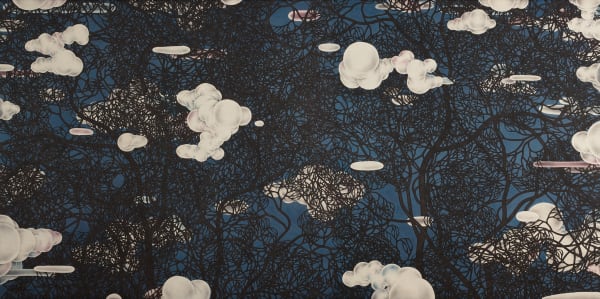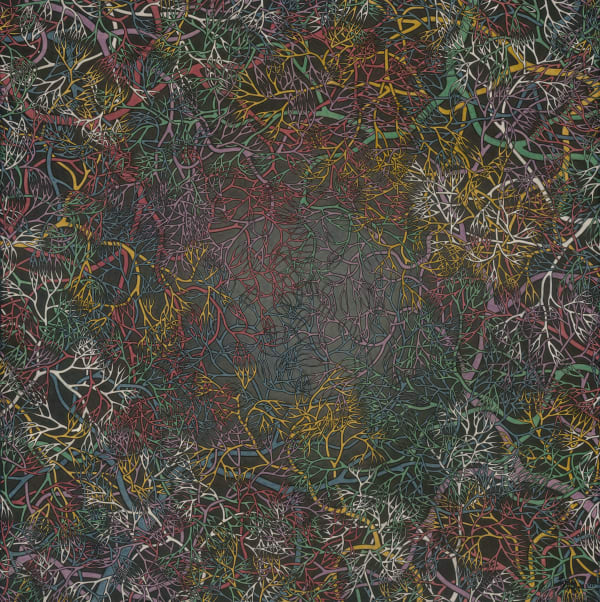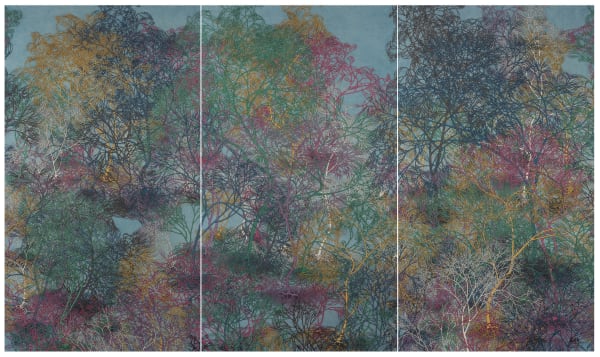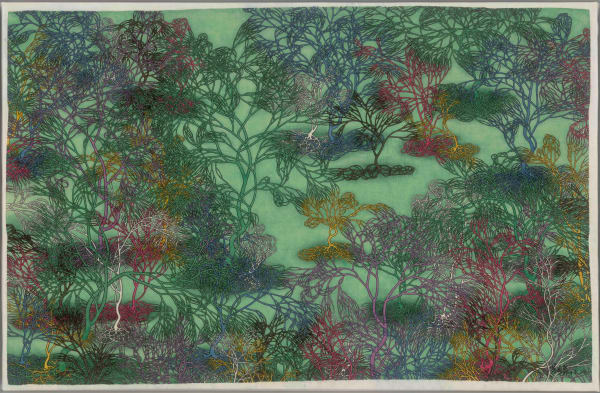1982 Born in Guangdong, China.
Lao Tongli is a contemporary artist working in early gongbi or "meticulous brush" painting technique-a tradition which can trace its roots to Imperial painting of the Song Dynasty (960-1279) and religious mural painting dating as far back as the the Six Dynasties period (220-589). Unlike China's literati painting tradition which emphasized landscape painting in ink monochrome, gongbi painting often depicted moral, spiritual and religious narratives using vibrant mineral pigments such as azurite, malachite, lapis lazuli, lead, cobalt and cinnabar. Having entered China as early as the 3rd Century along the Silk Road from Central Asia, gongbi painting facilitated cross-cultural artistic exchange between China, Central Asia, the Middle East and perhaps even Europe over the ensuing millennia. As a result, gongbi painting shares many of the same materials and techniques found in European fresco painting, Persian or South Asian miniature painting and Tibetan thanka painting. Having mastered gongbi painting methods at the Guangzhou Academy of Fine Arts, Lao Tongli spent two years, following his graduation in 2006, working in France and Germany for international contemporary artist Yang Jiechang, himself a master of gongbi painting technique. There he developed a novel approach to gongbi painting that reformulates both the technique and the visual semiotics of this early transnational art form for use in our international, contemporary art discourse today.
In expanding the visual semiotics of gongbi painting, Lao Tongli starts with a simple philosophical premise that universal or trans-cultural human meaning emerges first as personal, subjective experience. Although a topic of only secondary concern in Western thought, subjective experience is the starting point for much of Chinese and East Asian art and philosophy. In his The Desire of Libido series (2013-2018), for example, Lao Tongli's expansive compositions, at first glance, evoke the monumental landscapes of the Northern Song period. Upon closer inspection, however, these monumental forms dissolve into a dense network of branches and twigs resembling a forest canopy. Closer still, this panorama of interwoven trees dissolves yet again into a complex web of interconnected blood vessels. The artist first came upon this imagery as physicians cared for his father who was ailing from heart disease. The association of the blood vessels in the heart — which in Chinese philosophy is the seat of one's humanity — with an external landscape of trees — which represent the life-generating virtue of the natural world — is a poignant and deeply personal invocation of the deep and unbreakable bond between humans and nature-the classical Chinese idea of tian ren he yi. In the series Above the Horizon Sky (2018-present), Lao Tongli expands this lexicon to include the sky-which, in classical Chinese philosophy, represents the natural order of the cosmos and, in contemporary ecological studies, encompasses the atmosphere, parts of the hydrosphere and the source of all life energy on earth, sunlight. In the more recent series Self and Others (2021-present), Lao Tongli further extends this lexicon of images to include the human body — our individual "self" — in relation to a larger ecosystem of "other" living organisms of which we are just a part. Drawing from his own life experience, Lao Tongli has thus uncovered images that link early Chinese cosmology with contemporary ecological thinking. In this way, the conceptual concerns that appear to guide his artistic practice from outside, in fact, emerged organically and dialogically from his internal and more fundamental exploration of personal experience.
In constructing a contemporary visual semiotics for gongbi painting, Lao Tongli has also systematically extended and reformulated its methods of depiction. In traditional gongbi technique, forms were depicted using fine ink outline and color was used to fill the space between these lines. The overall effect was descriptive and gongbi artists could achieve high levels of formal resemblance using these simple methods. In traditional xieyi or "calligraphically expressive" painting, on the other hand, the brushline depicted not just form (iconically) but flow and motion (indexically). Lao Tongli combines these two modes of linework in what he calls a "double brushline." Instead of using one brushline to indexically depict the flow of energy through a branch or twig, Lao Tongli uses a double brushline to both descriptively outline and schematically depict the structures — the walls of a blood vessel for example — that contain and direct that flow. Among other things, this allows him to depict the polysemous complex network structures that populate his semiotic system. Lao Tongli also expands the utilization of mineral pigments not just to fill the space between ink outline but to outline the form itself. Among other things, this liberates color from it naturalistic, descriptive function and allows Lao Tongli to employ color temperature, harmony and dissonance to imbue his lexicon of organic and natural forms with intangible, intrapsychic qualities such feeling, emotion and spiritual sense. Both of Lao Tongli's signature techniques — the ubiquitous use of the "double brushline" and the fusion of mineral pigment with brush outline — are themselves major advancements in the history of gongbi painting.
Lao Tongli has exhibited internationally in "Translations: Afro-Asian Poetics," curated by Zoé Whitley for The Institutum, Singapore (2024), "We Do Not Dream Alone," curated by Boon Hui Tan for the Asia Society Triennial, Asia Society Museum, New York, USA (2020), "Excess Labor: Power Recycling | Paintings of Lao Tongli," Pearl River Museum of Art, Guangzhou, China (2019), "John Moores Painting Prize Exhibition," Minsheng Art Museum, Shanghai, China (2016), "Reform - Young Artist studying in France," Seven People Exhibition, Nürtingen Artists Association, Nürtingen, Germany (2015), "Hello, Xing Dao," South China Exhibition of Emerging Artists, 21 Tanjong Pagar Road, Singapore (2012), and "Infinitely Close to the Front: A Contemporary Art Exhibition of Death," Guangdong Museum of Art, Guangzhou, China (2011). His works can be found in the collection of the Guangdong Museum of Art, among others.
-
 As High As the Clouds 与云齐, 2023
As High As the Clouds 与云齐, 2023 -
 Horizon·Positive Negative Zero Zero No. 06 地平线·正负零零06号, 2023
Horizon·Positive Negative Zero Zero No. 06 地平线·正负零零06号, 2023 -
 In and Out of the Clouds No. 01 云里云外01号, 2023
In and Out of the Clouds No. 01 云里云外01号, 2023 -
 Self and the Others No. 04 自我与他者04号, 2023
Self and the Others No. 04 自我与他者04号, 2023 -
 Self and the Others No. 06 自我与他者06号, 2023
Self and the Others No. 06 自我与他者06号, 2023 -
 Above the Horizon·Sky No. 04 地平线之上·天空04号 , 2021
Above the Horizon·Sky No. 04 地平线之上·天空04号 , 2021 -
 Horizon·Positive Negative Zero Zero No. 04 地平线·正负零零04号, 2020
Horizon·Positive Negative Zero Zero No. 04 地平线·正负零零04号, 2020 -
 The Desire of Libido No. 05 丽比多之欲05号, 2017
The Desire of Libido No. 05 丽比多之欲05号, 2017 -
 Loneliness No. 11 寂11号, 2016
Loneliness No. 11 寂11号, 2016 -
 The Desire of Libido·Above the Horizon No. 03 丽比多之欲·地平之上03号, 2015
The Desire of Libido·Above the Horizon No. 03 丽比多之欲·地平之上03号, 2015 -
 Color·Blue No. 02 色域·蓝02号, 2012
Color·Blue No. 02 色域·蓝02号, 2012













